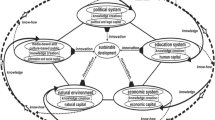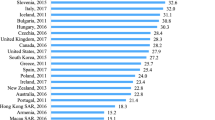Abstract
The aspirations gap is the distance between an individual’s current and aspired standard of livelihood. A growing theoretical literature predicts that aspirations both “too close” and “too far” away from current standards lead to less investment in the future. These theories imply an inverted U-shaped relationship between the aspirations gap and investments. I test this hypothesis and extend existing empirical findings to rural Myanmar by examining the relationship between the income aspirations gap and real estate investment choices. I find that income aspirations that are ahead, but not too far ahead, of current income levels provide the best incentive for investment. Analysis of heterogeneity highlights that this relationship is strongest for those with relatively low income and those who hold fatalistic beliefs. These findings suggest the presence of psychological constraints to poverty alleviation and development in rural Myanmar.
Similar content being viewed by others
References
Altonji, J.G., Elder, T.E., Taber, C.R.: Selection on Observed and Unobserved Variables: Assessing the Effectiveness of Catholic Schools?. Journal of Political Economy 113(1), 151–184 (2005)
Appadurai, S.: The Capacity to Aspire: Culture and the Terms of Recognition. In: Culture and Public Action, pp. 59–84 (2004)
Ashraf, N., Karlan, D., Yin, W.: Tying odysseus to the mast: evidence from a commitment savings product in the Philippines. Q. J. Econ. 121, 535–672 (2006)
Bandiera, O., Rasul, I.: Social networks and technology adoption in northern mozambique. The Economic Journal 116(514), 869–902 (2006)
Banerjee, A., Mullainathan, S.: The shape of temptation: implications for the economic lives of the poor. NBER Working Paper, 15973 (2010)
Beaman, L., Duflo, E., Pande, R., Topalova, P: Female leadership raises aspirations and educational attainment for girls: a policy experiment in India. Science 335, 582–586 (2012)
Becker, G., Tomes, N.: An equilibrium theory of the distribution of income and intergenerational mobility. J. Polit. Econ. 87(6), 1153–1189 (1979)
Bellemare, M., Wichman, C.J.: Elasticities and the Inverse Hyperbolic Sine Transformation. Oxford Bulletin of Economics and Statistics, forthcoming (2019)
Bellows, J., Miguel, E.: War and local collective action in Sierra Leone. Journal of Public Economics 93(11–12), 1144–1157 (2009)
Bernard, T., Taffesse, A.S.: Aspirations: An approach to measurement with validation using Ethiopian Data. J. Afr. Econ. 32(2), 189–224 (2014)
Bernard, T., Dercon, S., Orkin, K., Taffesse, A.S.: “The future in mind” aspirations and forward-looking behavior in rural ethiopia” Centre for the Study of African Economies. University of Oxford, Working Paper (2014)
Bernheim, B., Ray, D., Yeltekin, S.: Self-Control, saving, and the low asset trap. Mimeo. Department of Economics, New York University (1999)
Bernheim, B.D., Ray, D., Yeltekin, S.: Poverty and Self-Control. Econometrica 85(5), 1877–1911 (2015)
Besley, T.: Aspirations and the political economy of inequality. Oxford Economic Papers 69(1), 1–35 (2016)
Bloem, J., Boughton, D., Htoo, K., Hein, A., Payongayong, E.: Measuring hope: a quantitative approach with validation in rural myanmar. J. Dev. Stud. 54(11), 2078–2094 (2018)
Bogliacino, F., Ortoleva, P.: The Behavior of Others as a Reference Point. Columbia Business School Research Paper, No. 13-55 (2013)
Bogliancino, F., Ortoleva, P.: The Behavior of Others as a Reference Point. Documentos FCE-CID Escuela de Economia, Universidad Nacional de Colombia Sede Bogota (2015)
Bryan, G., Chowdhury, S., Mobarak, A.M.: Underinvestment in a profitable technology: the case of seasonal migration in bangladesh. Econometrica 82(5), 1671–1748 (2014)
Burbidge, J.B., Magee, L., Robb, A.L.: Alternative transformations to handle extreme values of the dependent variable. J. Am. Stat. Assoc. 83(401), 123–127 (1988)
Dalton, P.S., Ghosal, S., Mani, A.: Poverty and aspirations failure. The Economic Journal 126, 165–188 (2016)
Dercon, S., Singh, A.: From nutrition to aspirations and self-efficacy: gender bias over time among children in four countries. World Dev. 45, 31–50 (2013)
Duflo, E., Kremer, M., Robinson, J.: Nudging farmers to use fertilizer: theory and experimental evidence from kenya. American Economic Review 101, 2350–2390 (2011)
Favara, M.: Do dreams come true? aspirations and educational attainments of ethiopian boys and girls. J. Afr. Econ. 26(5), 561–583 (2017)
Freeman, S.: Equilibrium income inequality among identical agents. J. Polit. Econ. 104(5), 1047–1064 (1996)
Galiani, S., Gertler, P.J., Undurraga, R.: Aspiration Adaptation in Resource-Constrained Environments, NBER Working Paper, no. 24264 (2018)
Garcia, S., Harker, A., Cuartas, J.: Building dreams: the short-term impacts of a conditional cash transfer program on aspirations for higher education. Int. J. Educ. Dev. 64, 48–57 (2019)
Genicot, G., Ray, D.: Aspirations and inequality. Econometrica 85(2), 489–519 (2017)
Gonzalez, F., Miguel, E.: War and local collective action in Sierra Leone: A comment on the use of coefficient stability approaches. Journal of Public Economics 128, 30–33 (2015)
Griliches, Z., Ringstad, V.: Error-in-the-variables bias in nonlinear contexts. Econometrica 38(2), 368–370 (1970)
Hein, A., Htoo, K., Seng Kham, L., Win, M.T., Thinzar, A.M., Naing, Z.M., Mi, W.T., Ni, L., Min, L.U., Mwee, N.E., Oo, Z., Filipski, M., Nischan, U., Asselt, J.V., Holtemeyer, B., Schmidt, E., Kedir, M., Kennedy, A., Zhang, X., Dorosh, P., Payongayong, E., Belton, B., Boughton, D.: Rural livelihoods in mon state, myanmar: evidence from a representative household survey. Feed the Future Innovation Lab for Food Security Policy, Research Paper, No. 20 (2016)
Janzen, S.A., Magnan, N.P., Sharma, S., Thompson, W.: Aspirations failure and formation in rural nepal. Journal of Economic Behavior & Organization 139, 1–25 (2017)
Kahneman, D., Tversky, A.: Prospect Theory: An Analysis of Decision under Risk. Econometrica 47(2), 263–292 (1979)
Knight, J., Gunatilaka, R.: Income, aspirations and the Hedonic Treadmill in a poor society. Journal of Economic Behavior & and Organization 82(1), 67–81 (2012)
La Ferrara, E.: Aspirations, Social Norms, and Development. Journal of the European Economic Association, 2019 European Economic Association Presidential Address, forthcoming (2019)
Lind, J.T., Mehlum, H.: With or without U? The appropriate test for a u-shaped relationship. Oxf. Bull. Econ. Stat. 72, 109–118 (2010)
Loury, G.: Intergenerational transfers and the distribution of earnings. Econometrica 49(4), 843–867 (1981)
Lybbert, T., Wydick, B.: Poverty, aspirations, and the economics of hope. Econ. Dev. Cult. Chang. 66(4), 709–753 (2018)
Macours, K., Vakis, R.: Changing households’ investment behavior through social interactions with local leaders: evidence from a randomized transfer program. The Economic Journal 124, 607–633 (2014)
MacKinnon, J.G., Magee, L.: Transforming the Dependent Variable in Regression Models. International Economic Review 31(2), 315–339 (1990)
McKenzie, D.: Beyond baseline and follow-up: The case for more T in experiments. Journal of Development Economics 99(2), 210–221 (2012)
Mookherjee, D, Ray, D., Napel, S.: Aspirations, segregation, and occupational choice. J. Eur. Econ. Assoc. 8, 139–168 (2010)
Mookerjee, D., Ray, D.: Persistent inequality. Review of Economic Studies 70(2), 369–394 (2003)
Oster, E.: Unobservable Selection and Coefficient Stability: Theory and Evidence. Journal of Business and Economic Statistics 37(2) (2019)
Page, L., Pande, R.: Ending Global Poverty: Why Money Isn’t Enough. Journal of Economic Perspectives 32(4), 173–200 (2018)
Pasquier-Doumer, L., Brandon, F.R.: Aspiration failure: a poverty trap for indigenous children in peru?. World Dev. 72, 208–223 (2015)
Pence, K.M.: The Role of Wealth Transformations: An Application to Estimating the Effect of Tax Incentives on Saving. Contributions to Economic Analysis & Policy 5(1), 1–24 (2006)
Piketty, T.: Capital in the Twenty First Century. Harvard University Press, Cambridge (2014)
Rahman, K.W.: “Does international migration affect school choice in source country? evidence from Bangladesh,” University of minnesota working paper, unpublished manuscript (2019)
Ray, D.: Aspirations, poverty, and economic change. In: Understanding Poverty, vol. 28. Oxford University Press, pp. 409–421 (2006)
Rizzica, L.: Raising aspirations and higher education: evidence from the united kingdom’s widening participation policy. J. Labor Econ. 38(1), 183–214 (2020)
Robinson, P.M.: Root-n-consistent semiparametric regression. Econometrica 56, 931–954 (1988)
Ross, P.H.: Occupation aspirations, education investment, and cognitive outcomes: Evidence from Indian adolescents. World development, vol 123, November 2019 (2019)
Sasabuchi, S.: A test of a multivariate normal mean with composite hypotheses determined by linear inequalities. Biometrika 67, 429–439 (1980)
Suri, T.: Selection and comparative advantage in technology adoption. Econometrica 79(1), 159–209 (2011)
Verardi, V., Debarsy, N.: Robinson’s square root of n consistent semiparametric regression estimator in Stata. Stata Journal 12(4), 726–735 (2012)
Wuepper, D., Lybbert, T.: Perceived self-efficacy, poverty, and economic development. Ann. Rev. Resour. Econ. 9, 383–404 (2017)
Yatchew, A.: Nonparametric regression techniques in economics. J. Econ. Lit. 57, 135–143 (1988)
Acknowledgments
I am grateful to Marc Bellemare, Jason Kerwin, Paul Glewwe, Bruce Wydick, Nicholas Magnan, Jane Sumner, Khandker Wahedur Rahman, and two anonymous reviewers for constructive feedback on this paper. I want to acknowledge the wonderful guidance and assistance of Duncan Boughton, Ellen Payongayong, Kyan Htoo, and Aung Hein when conducting field-work and collecting data used in this project. I am thankful for helpful feedback from participants of the 2019 Midwest International Economic Development Conference (MidDev) at the University of Wisconsin, Madison, the 2019 Agricultural and Applied Economics Association (AAEA) Meetings in Atlanta, GA, and the 2019 Sustainability and Development Conference at the University of Michigan. I am also thankful to the United States Agency for International Development (USAID) for generous funding, provided through the Feed the Future Innovation Lab for Food Security Policy at Michigan State Univeristy (RC104236 USAID Burma). I am also appreciative of support from the Doctoral Dissertation Fellowship (DDF) from the Graduate School at the University of Minnesota. The findings and conclusions in this manuscript are mine and should not be construed to represent any official USDA or US Government determination or policy. This research was conducted prior to my employment with the USDA. All errors are my own.
Author information
Authors and Affiliations
Corresponding author
Additional information
Publisher’s Note
Springer Nature remains neutral with regard to jurisdictional claims in published maps and institutional affiliations.
Electronic supplementary material
Below is the link to the electronic supplementary material.
Rights and permissions
About this article
Cite this article
Bloem, J.R. Aspirations and investments in rural Myanmar. J Econ Inequal 19, 727–752 (2021). https://doi.org/10.1007/s10888-021-09478-7
Received:
Accepted:
Published:
Issue Date:
DOI: https://doi.org/10.1007/s10888-021-09478-7




